Introduction
In today’s modern world, the need for uninterrupted and reliable power supply has become a necessity for every household. With increasing reliance on electronic devices and appliances, a power outage can significantly disrupt our daily routines and cause inconvenience.
This is where inverters come into play, providing a crucial solution for maintaining a comfortable and smart living environment.
In this comprehensive guide, we will explore the world of inverters for home use, decoding their functionality, applications, and the numerous benefits they offer.

What are inverters for home use ?
Inverters for home use are small devices that converts direct current to alternating current, allowing our household appliances and electronic devices to function properly.
Working Principle of Inverters
Inverters convert direct current(DC) to alternating current(AC).

Let me briefly explain the inverter process.
Step 1 DC Input:
Inverters are usually connected to a DC power source such as batteries, solar panels and other DC power sources.
Step 2 Inverter Process:
The inverter process is mainly to convert DC power into AC power. This process consists of 2 components.
Conversion
The DC input first passes through a conversion stage, which usually consists of electronic switches (e.g., transistors) arranged in a specific configuration to pass the DC input signal through the switches of these electronic components to produce a pulsating waveform.
Filtering
The pulsating AC signal generated by the conversion is passed through a filtering stage. This stage smoothes the waveform by removing high frequency components and any undesired harmonics to obtain a clearer sinusoidal AC waveform.
Step 3 Output:
Finally, the filtered AC signal is amplified to the desired voltage level and output or supplied to the electrical system through the AC socket of the inverter.
Inverter applications in the home
There are several common uses for inverters in the home:.
- Backup power systems.
They can be integrated with batteries and during a power outage, the inverter switches to battery power to provide uninterrupted power to critical appliances and lighting in the home. - Solar Power Systems.
They convert the DC power generated by solar panels into AC power, which can be used to power household appliances and fed into the grid. - Off-Grid Living.
Inverters are essential for off-grid living setups in homes that are not connected to the utility grid. - Voltage Regulation and Regulation:
Inverters also provide voltage regulation to ensure a stable, clean power supply to sensitive electronic devices in the home. Important in areas where grid power is unstable, inverters can help protect appliances from voltage fluctuations. - Portable power solutions:
Portable inverters allow homeowners to power small appliances and electronics away from traditional power sources. These inverters are small and lightweight, making them suitable for camping trips, outdoor activities, or powering tools.
Energy Saving and Environmental Protection
Efficient energy conversion:
Inverters efficiently convert DC power, such as solar panels or batteries, into AC power for domestic use, reducing energy loss during the conversion process, reducing overall energy consumption and environmental impact.
Demand Side Management:
Inverters equipped with advanced control features help optimize home energy use.
For example, smart inverters can dynamically adjust output voltage and frequency based on real-time demand, improving overall system efficiency, reducing the need for additional electricity and lowering greenhouse gas emissions.
Battery Energy Storage:
Using an inverter in conjunction with a battery storage system allows excess energy generated from renewable sources to be stored for use during periods of high demand or when renewable generation is not available. By storing power when energy is plentiful and discharging it when it is needed, it helps balance supply and demand and reduces reliance on fossil fuel power plants.
Installation and Maintenance Guide
Installation
Here are some general steps for installing a home inverter:
- Assess your power needs: Determine the total wattage of the appliances and devices you want to power during an outage, considering both essential and non-essential loads.
- Choose the right inverter: Select an inverter with sufficient capacity to handle your power requirements, taking into account potential future expansions.
- Install the inverter: Follow the manufacturer’s instructions for mounting the inverter in a suitable location, such as a dedicated utility room or cabinet.
- Connect the power sources: Wire the inverter to the appropriate power sources, such as batteries, solar panels, or generators, ensuring proper safety measures are followed.
- Connect the loads: Connect the appliances and devices you wish to power during an outage to the inverter’s output terminals.
- Test the system: Once installation is complete, test the inverter by simulating a power outage or switching to the alternative power source to ensure proper functionality.
Maintenance
Regular maintenance is essential to ensure the optimal performance and longevity of your Inverters for Home Use.
This includes tasks such as inspecting connections, cleaning air filters, and checking battery levels. Additionally, it is recommended to have your inverter professionally serviced by a qualified technician every 1-2 years to identify and address any potential issues.

Choosing the Right Inverters for Home Use
With the wide array of Inverters for Home Use available in the market, choosing the right one for your home can be a daunting task. Here are some key factors to consider when selecting an inverter:
- Power requirements: Determine the total wattage of the appliances and devices you need to power during an outage, and choose an inverter with sufficient capacity to handle your loads.
- Battery backup: Consider the runtime required for your essential loads and choose an inverter with the appropriate battery backup capacity.
- Input voltage: Ensure that the inverter’s input voltage matches the voltage of your power source, whether it’s a battery bank, solar panels, or a generator.
- Output voltage and frequency: Most household appliances require a standard output voltage of 120V or 240V and a frequency of 60Hz or 50Hz, depending on your location.
- Efficiency and power factor: Look for inverters with high efficiency ratings and power factor correction capabilities to optimize energy usage and reduce waste.
- Safety features: Choose inverters with built-in safety features, such as overload protection, short-circuit protection, and automatic shutdown in case of abnormal conditions.
- Brand reputation and warranty: Consider reputable brands known for their quality and reliability, and opt for inverters with comprehensive warranties and customer support.
Conclusion
Inverters for home use have revolutionized the way we manage and utilize power in our homes. By providing backup power during outages, enabling the integration of renewable energy sources, and promoting energy efficiency, inverters have become an essential component of modern and sustainable living.
Whether you’re seeking reliable backup power, exploring off-grid living options, or aiming to reduce your carbon footprint, investing in a high-quality inverter for your home can be a game-changer. With the right inverter and a comprehensive understanding of its applications and benefits, you can create a comfortable, sustainable, and truly smart living environment for you and your family.
Contact Us
For more informations of Inverters for Home Use, visit our website or contact professional team:
